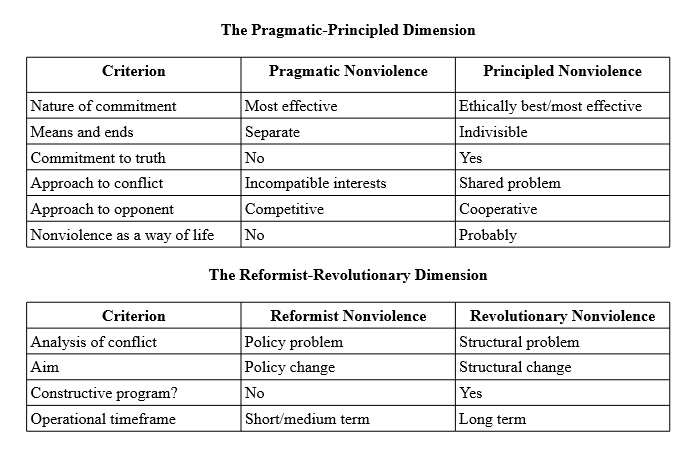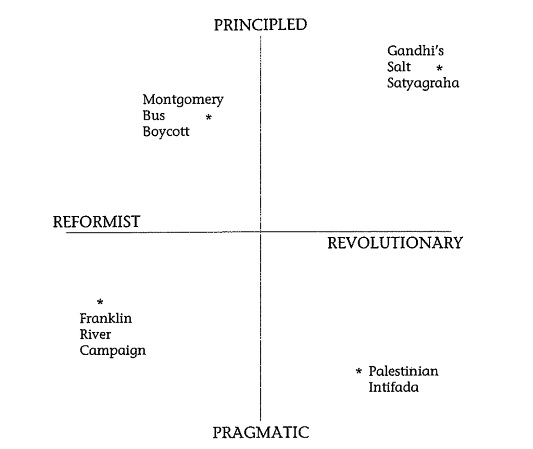
Conception of Nonviolence
There are many types of nonviolence.
While Gandhi made a distinction between those committed to nonviolence as a creed and those who used it as a policy, more recent authors have recast this distinction in a variety of ways. Most frequently, a distinction is made between those whose commitment to nonviolence is ‘principled’ and those whose commitment is ‘pragmatic’. Specifically, the pragmatic-principled dimension is used to indicate the nature of the commitment to nonviolence and to the truth, as well as the approach to conflict which activists utilize: this includes the importance attached to the relationship between means and end and the attitude towards the opponent.
Separately from this distinction, another dimension may be identified. The reformist-revolutionary dimension is used to indicate the type of analysis, the ultimate aim and the operational timeframe which activists utilize.
Practitioners of pragmatic nonviolence believe it to be the most effective method available in the circumstances. They view conflict as a relationship between antagonists with incompatible interests; their goal is to defeat the opponent. Practitioners of principled nonviolence choose it for ethical reasons; they believe in telling the truth and in the unity of means and end. They view the opponent as a partner in the struggle to satisfy the needs of all. More fundamentally, they may view nonviolence as a way of life.
Practitioners of reformist nonviolence are guided by an analysis which identifies particular elite policies as the cause of social problems. They use short to medium term campaigns to change these policies within the existing social framework; their aim is reform. Practitioners of revolutionary nonviolence are guided by a structural analysis of political and economic relationships and believe there is a need for fundamental structural change; particular campaigns (which may have a short to medium term timeframe) are thus conducted within the context of a long-term revolutionary strategy.
To summarize, the criteria which underpin these two dimensions of nonviolence are itemized in the table below.
By reference to their standing in relation to the criteria itemized in the table, it is possible to identify the orientation of individual activists and particular campaigns, and to locate them in one of four categories of nonviolence. For example, most anti-nuclear and environmental campaigns, such as those related to climate activism, fall into the pragmatic-reform category. Most campaigns with a religious perspective (such as the Montgomery bus boycott led by Rev. Martin Luther King Jr.) are examples of the principled-reform category. The Palestinian Intifadas, the Color Revolutions and the Arab Spring are examples of the pragmatic-revolutionary category. And many of Gandhi’s campaigns (including the Salt Satyagraha) were clearly in the principled-revolutionary category.
These categories are obviously broadly descriptive rather than definitive because individuals or campaigns may adopt a particular approach but utilize characteristics normally associated with another approach.
The commitment of individual activists and the nature of particular campaigns can also be illustrated graphically – according to the strength of their standing in relation to each of the criteria identified in the table – on the matrix below. They may be located in any quadrant on the matrix, near to or far from a particular axis, and at various distances from the origin.
Hence, given the existence of various conceptions of nonviolence, your strategic plan should:
(i) identify the particular conception of nonviolence that your campaign will utilize;
(ii) identify the specific ways in which your commitment to nonviolence will be conveyed to all parties so that the benefits of adopting a nonviolent strategy are maximized; and
(iii) identify how the level of discipline required to implement your nonviolent strategy will be developed. This includes defining the ‘action agreements’ (code of nonviolent discipline) that will guide activist behaviour.
It is important to make a deliberate strategic choice regarding the conception of nonviolence that will underpin your strategy. If your intention is to utilize the strategic framework outlined here, it is vitally important to recognize that this framework is based on the Gandhian (principled/revolutionary) conception of nonviolence illustrated below.
This is because Gandhi’s nonviolence is based on certain premises, including the importance of the truth, the sanctity and unity of all life, and the unity of means and end, so his strategy is always conducted within the framework of his desired political, social, economic and ecological vision for society as a whole and not limited to the purpose of any immediate campaign. It is for this reason that Gandhi’s approach to strategy is so important. He is always taking into account the ultimate end of all nonviolent struggle – a just, peaceful and ecologically sustainable society of self-realized human beings – not just the outcome of this campaign. He wants each campaign to contribute to the ultimate aim, not undermine vital elements of the long-term and overarching struggle to create a world without violence.
This does not mean, however, that each person participating in the strategy must share this commitment; they may participate simply because it is expedient for them to do so. This is not a problem as long as they are willing to commit to the code of nonviolent discipline.
To reiterate: the table below defines the primary criteria used in distinguishing the different conceptions of nonviolence.
The Matrix of Nonviolence then illustrates these differences in graphic form, highlighting the primary differences between the Gandhian and other conceptions of nonviolence.


Matrix of Nonviolence
Source of this document: https://nonviolentstrategy.wordpress.com/strategywheel/conception-of-nonviolence/